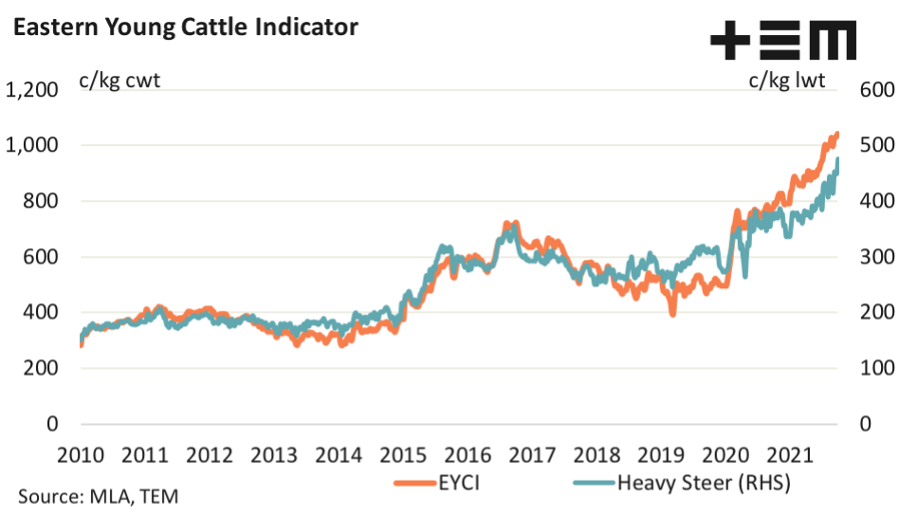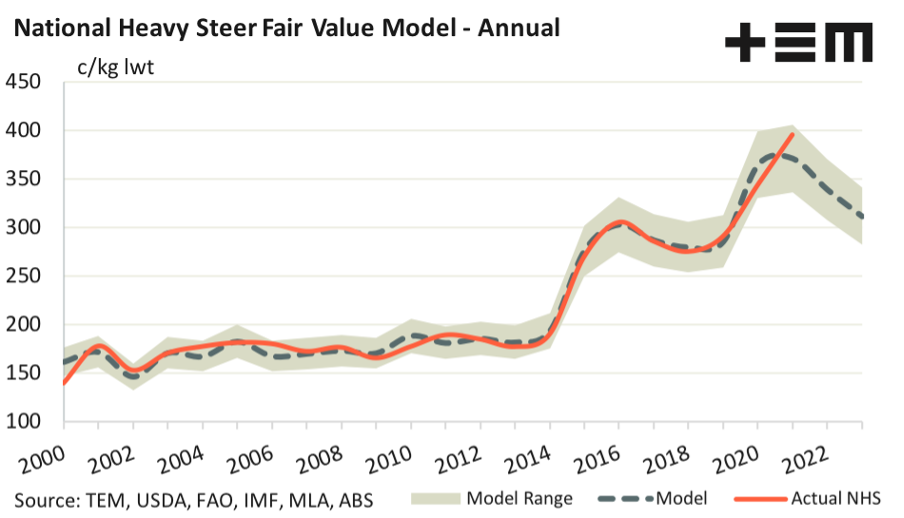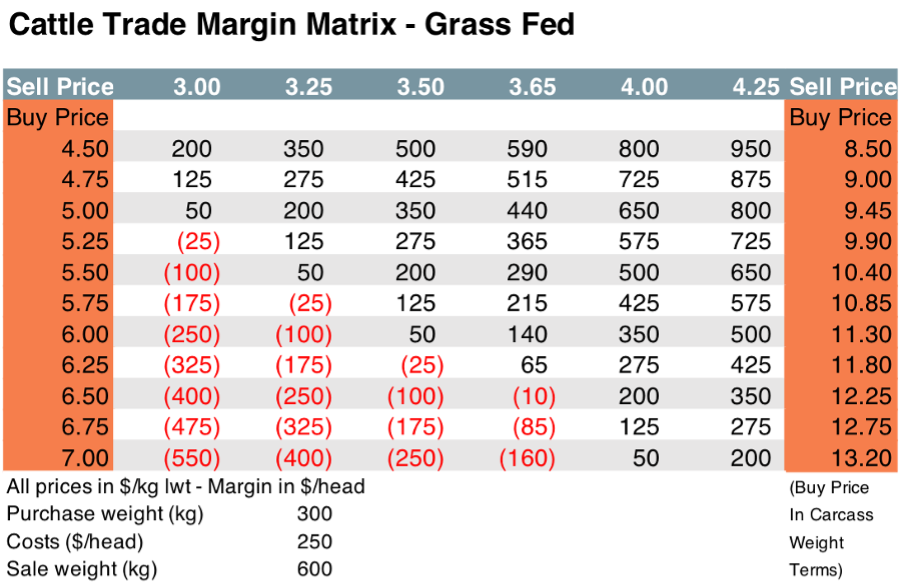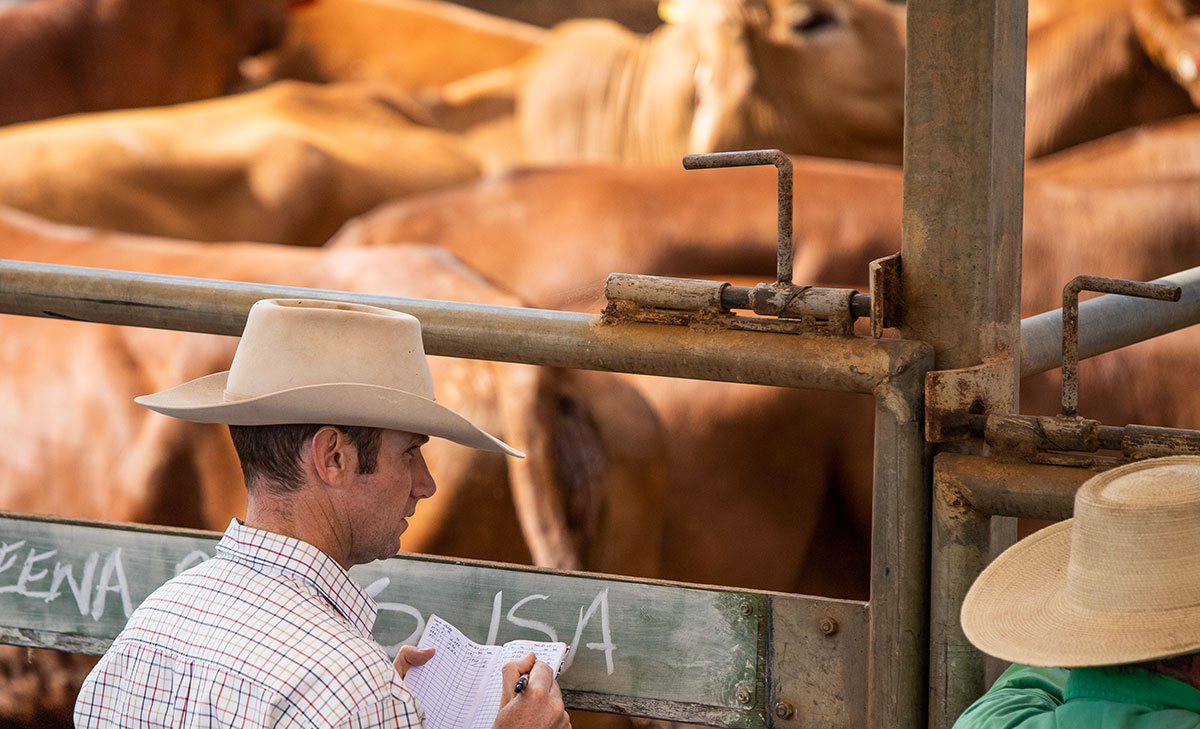Cattle markets are having a blinder of a season. Can money be made buying young cattle at these levels?
Author- Matt Dalgleish, Thomas Elder Markets
The Snapshot
- Currently, for the 2021 season TEM modelling shows an average annual price of 375 cents/kg lwt is fair value for the National Heavy Steer. As of the end of September the actual annual average was 395 cents.
- Projecting into 2022, using current estimates of all the variables that influence the heavy steer price, we can see that the model predicts an annual average of around 350 c/kg lwt, with a possible range of 305c/kg to 375c/kg.
- Buying young cattle at the current EYCI level of 10.40 $/kg cwt, or 5.50 $/kg lwt and selling in 2022 at the fair value model annual average estimate of 3.50 $/kg would bring a profit of $200 per head.
The Detail
Both the Eastern Young Cattle Indicator (EYCI) and the National Heavy Steer price have hit all time peaks as September 2021 came to a close. The EYCI at 1042 cents/kg carcass weight (cwt) and the National Heavy Steer surging 35 cents in a day to trade at 475 cents/kg liveweight (lwt).
At these phenomenal prices it begs the question if there is any money in buying young cattle at these prices. How long are finished cattle prices likely to remain this high for in order to turn off stock at a profit once weight has been added to the animal?

A good start is to focus on the average annual prices achieved over a season rather than the extremes. Thomas Elder Markets have created a fair value modelling tool that assesses various demand and supply factors that influence the price of heavy steers. The model can help to demonstrate if the current annual average price is above or below what would be considered fair value, based on the factors that influence its price.
The model looks at factors like; global cattle prices, the value of the Australian dollar, annual Australian cattle slaughter volumes, beef export flows, beef processor profitability, supply ratios between Australia and key offshore beef export competitors, and wealth levels in our primary beef export markets to derive a fair value estimate.
Currently, for the 2021 season the model shows an average annual value of 375 cents/kg lwt is the fair value for the National Heavy Steer. As of the end of September the actual annual average for the year to date was 395 cents.
We are yet to see if the heavy steer price will remain up at 475 cents for the remainder of the season. But, if it does, it will place the annual average National Heavy Steer price at close to 420 cents/kg lwt.

Projecting into 2022, using current estimates of all the variables that influence the heavy steer price, we can see that the model predicts an annual average of around 350 c/kg lwt, with a possible range of 305c/kg to 375c/kg. We can use this estimate to create a grass-fed cattle trade matrix that highlights the possibility of making money when buying young cattle at current price levels, near 1040 c/kg cwt.
Let’s assume the following trade scenario:
Buying a 300 kg yearling steer with the expectation of carrying through to sell at a weight of 600kg during 2022, with a carrying cost estimate of $250 per head on each steer to allow for factors such as agent fees, transport, supplements and the potential for some additional feed or other associated costs like finance (if applicable).
The matrix below shows the potential outcome of this grass-fed trade, in dollars per head profit or loss, at a variety of price entry and exit points. Buying young cattle at the current EYCI level of 10.40 $/kg cwt, or 5.50 $/kg lwt and selling in 2022 at the fair value model annual average estimate of 3.50 $/kg would bring a profit of $200 per head.

Assuming a better outcome on the sale, of say 4.00 $/kg lwt would generate a tidy $500 profit per steer. Indeed, heavy steer sale prices don’t start to hamper the profitability until you get towards a sale price closer to 3.00 $/kg lwt.
Producers with ample pasture and the confidence that they can turn off heavy steers in 2022 between $3.25 to $3.75 cents/kg lwt should feel comfortable buying young cattle at present levels.

